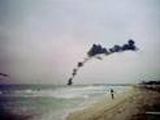 The fatal crash of a Grumman Turbo Mallard on Dec. 19, 2005, was caused by the failure and separation of the right wing, the NTSB said on Wednesday. That failure resulted from “(1) the failure of Chalk’s Ocean Airways’ maintenance program to identify and properly repair fatigue cracks in the wing, and (2) the failure of the FAA to detect and correct deficiencies in the company’s maintenance program.” The airplane had just departed from Miami on a regularly scheduled passenger flight to Bimini when it crashed into the shipping channel adjacent to the Port of Miami. Two flight crew and 18 passengers were killed, and the airplane was destroyed by impact forces. “This accident tragically illustrates a gap in the safety net with regard to older airplanes,” said NTSB Chairman Mark Rosenker. “The signs of structural problems were there, but not addressed. And to ignore continuing problems is to court disaster.”
The fatal crash of a Grumman Turbo Mallard on Dec. 19, 2005, was caused by the failure and separation of the right wing, the NTSB said on Wednesday. That failure resulted from “(1) the failure of Chalk’s Ocean Airways’ maintenance program to identify and properly repair fatigue cracks in the wing, and (2) the failure of the FAA to detect and correct deficiencies in the company’s maintenance program.” The airplane had just departed from Miami on a regularly scheduled passenger flight to Bimini when it crashed into the shipping channel adjacent to the Port of Miami. Two flight crew and 18 passengers were killed, and the airplane was destroyed by impact forces. “This accident tragically illustrates a gap in the safety net with regard to older airplanes,” said NTSB Chairman Mark Rosenker. “The signs of structural problems were there, but not addressed. And to ignore continuing problems is to court disaster.”
The Board found that neither the performance nor the appearance of the airplane would have provided a warning to the flight crew of the right wing’s imminent failure. The airplane was operating within its certificated design envelope and carrying normal aerodynamic loads when the wing separated. There was nothing the crew could have done to regain control of the airplane after the in-flight separation of the wing, the Board said. As a result of the investigation, the Board issued two new safety recommendations calling on the FAA to verify that airline maintenance programs include stringent criteria to address recurring or systemic problems, if necessary through comprehensive engineering evaluations; and, to modify procedures for oversight of maintenance programs of carriers like Chalk’s to ensure the continued airworthiness of the operator’s fleet. The full NTSB report will be available on the Web site at www.ntsb.gov in several weeks.


































